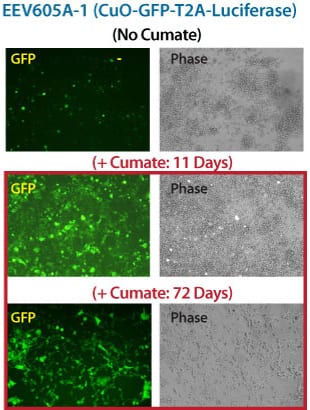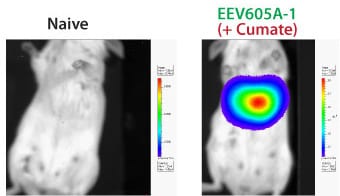CuO-GFP-T2A-Luciferase Enhanced Episomal Vector (EEV)
- High levels of expression
- Easy to clone formats
- No special plasmid production
- Nonviral, non-integrating technology
- Constitutive and inducible vector formats
Products
| Catalog Number | Description | Size | Price | Quantity | Add to Cart | |||
|---|---|---|---|---|---|---|---|---|
| EEV605A-1 | CuO-GFP-T2A-Luciferase Cumate-Inducible Dual Reporter Enhanced Episomal Vector (EEV) | 10 µg | $719 |
|
||||
Overview
Overview
An easy-to-produce non-integrating option for inducible GFP and luciferase expression
With virtually no limits on insert size (unlike AAV vectors) Enhanced Episomal Vectors (EEVs) are an excellent choice for non-integrating, non-viral gene expression. Because they replicate in synchrony with the host cell, they are stably inherited and can be used for long-lasting expression—up to several months both in vitro and in vivo—without modifying the host genome. Use SBI’s CuO-GFP-T2A-Luciferase EEV Vector (Cat.# EEV604A-2) for inducible and coordinated expression of GFP and luciferase reporters. The CuO promoter is a tightly-controlled inducible promoter which provides titratable gene expression in response to cumate.
 SBI’s EEV System, which is an enhanced version of the Epstein-Barr Nuclear Antigen-1 (oriP-EBNA1) system, offers:
SBI’s EEV System, which is an enhanced version of the Epstein-Barr Nuclear Antigen-1 (oriP-EBNA1) system, offers:
- High levels of expression
- Easy to clone formats
- No special plasmid production
- Nonviral, non-integrating technology
- Constitutive and inducible vector formats
References
How It Works
How It Works
Tightly-controlled, inducible gene expression
Get robust, titratable gene expression with low background using SBI’s cumate-inducible vectors. These vectors take advantage of CymR, a repressor that binds to cumate operator sequences (CuO) with high affinity in the absence of cumate, a non-toxic small molecule. Providing much lower background expression than similar systems, SparQ vectors can provide up to 32-fold induction of gene expression.
The cumate-inducible EEV reporter construct CuO-GFP-T2A-Luciferase (Cat.# EEV605A-1) features a cumate-inducible promoter driving the expression of GFP-T2A- Luciferase as well as a constitutive EF1α promoter expressing the CymR repressor and a Puromycin selection cassette. The EEV605A-1 cumate switch inducible reporter is silent until the addition of cumate (Cat# QM150A-1).
- Robust—increase expression up to 32-fold
- Adjustable—tune expression levels by titrating the amount of cumate
- Reversible—turn expression on, then off, then on again
- Powerful—suitable for in vivo applications
Supporting Data
Supporting Data
Sustained, inducible, and non-integrating gene expression in vitro and in vivo with EEV
Figure 1. The inducible EEV reporter CuO-GFP-T2A-Luciferase delivers robust gene expression in vitro over 72 days. The EEV reporter CuO-GFP-T2A-Luciferase was transfected into HEK293 cells. Cumate was added to the medium daily at a final concentration of 300 µg/ml and cells imaged for GFP signal. GFP induction appeared after two days and expression detected for 72 days (2.5 months) after the original transfection, demonstrating just how long-lasting episomal expression delivered with EEV vectors can be.
Figure 2. The inducible EEV reporter CuO-GFP-T2A-Luciferase delivers robust gene expression in vivo. The Cumate inducible EEV reporter was also tested in mice. 5 µg of CuO-GFP-T2A-Luciferase plasmid (Cat.# EEV605A-1) was introduced into three test mice (n=3) via hydrodynamic tail vein injection (HDD) on Day 0. EEV expression was induced by IP injection of 1.5 mg of the water-soluble version of cumate (cat# QM150A-1). Mice were then imaged for luminescence activity through full body scans on Day 2. The high luciferase activity detected demonstrates the ability of the inducible EEV reporter to deliver robust gene expression upon induction.
FAQs
Documentation
Citations
Related Products
Products
| Catalog Number | Description | Size | Price | Quantity | Add to Cart | |||
|---|---|---|---|---|---|---|---|---|
| EEV605A-1 | CuO-GFP-T2A-Luciferase Cumate-Inducible Dual Reporter Enhanced Episomal Vector (EEV) | 10 µg | $719 |
|
||||
Overview
Overview
An easy-to-produce non-integrating option for inducible GFP and luciferase expression
With virtually no limits on insert size (unlike AAV vectors) Enhanced Episomal Vectors (EEVs) are an excellent choice for non-integrating, non-viral gene expression. Because they replicate in synchrony with the host cell, they are stably inherited and can be used for long-lasting expression—up to several months both in vitro and in vivo—without modifying the host genome. Use SBI’s CuO-GFP-T2A-Luciferase EEV Vector (Cat.# EEV604A-2) for inducible and coordinated expression of GFP and luciferase reporters. The CuO promoter is a tightly-controlled inducible promoter which provides titratable gene expression in response to cumate.
 SBI’s EEV System, which is an enhanced version of the Epstein-Barr Nuclear Antigen-1 (oriP-EBNA1) system, offers:
SBI’s EEV System, which is an enhanced version of the Epstein-Barr Nuclear Antigen-1 (oriP-EBNA1) system, offers:
- High levels of expression
- Easy to clone formats
- No special plasmid production
- Nonviral, non-integrating technology
- Constitutive and inducible vector formats
References
How It Works
How It Works
Tightly-controlled, inducible gene expression
Get robust, titratable gene expression with low background using SBI’s cumate-inducible vectors. These vectors take advantage of CymR, a repressor that binds to cumate operator sequences (CuO) with high affinity in the absence of cumate, a non-toxic small molecule. Providing much lower background expression than similar systems, SparQ vectors can provide up to 32-fold induction of gene expression.
The cumate-inducible EEV reporter construct CuO-GFP-T2A-Luciferase (Cat.# EEV605A-1) features a cumate-inducible promoter driving the expression of GFP-T2A- Luciferase as well as a constitutive EF1α promoter expressing the CymR repressor and a Puromycin selection cassette. The EEV605A-1 cumate switch inducible reporter is silent until the addition of cumate (Cat# QM150A-1).
- Robust—increase expression up to 32-fold
- Adjustable—tune expression levels by titrating the amount of cumate
- Reversible—turn expression on, then off, then on again
- Powerful—suitable for in vivo applications
Supporting Data
Supporting Data
Sustained, inducible, and non-integrating gene expression in vitro and in vivo with EEV
Figure 1. The inducible EEV reporter CuO-GFP-T2A-Luciferase delivers robust gene expression in vitro over 72 days. The EEV reporter CuO-GFP-T2A-Luciferase was transfected into HEK293 cells. Cumate was added to the medium daily at a final concentration of 300 µg/ml and cells imaged for GFP signal. GFP induction appeared after two days and expression detected for 72 days (2.5 months) after the original transfection, demonstrating just how long-lasting episomal expression delivered with EEV vectors can be.
Figure 2. The inducible EEV reporter CuO-GFP-T2A-Luciferase delivers robust gene expression in vivo. The Cumate inducible EEV reporter was also tested in mice. 5 µg of CuO-GFP-T2A-Luciferase plasmid (Cat.# EEV605A-1) was introduced into three test mice (n=3) via hydrodynamic tail vein injection (HDD) on Day 0. EEV expression was induced by IP injection of 1.5 mg of the water-soluble version of cumate (cat# QM150A-1). Mice were then imaged for luminescence activity through full body scans on Day 2. The high luciferase activity detected demonstrates the ability of the inducible EEV reporter to deliver robust gene expression upon induction.




